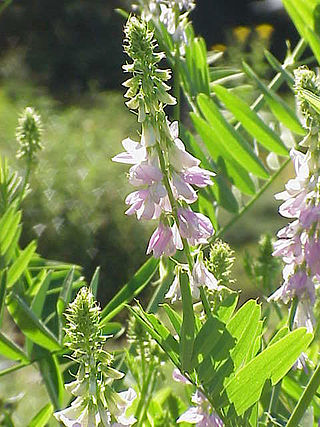
Bioprospecting is the exploration of natural sources for small molecules, macromolecules and biochemical and genetic information that could be developed into commercially valuable products for the agricultural, aquaculture, bioremediation, cosmetics, nanotechnology, or pharmaceutical industries. In the pharmaceutical industry, for example, almost one third of all small-molecule drugs approved by the U.S. Food and Drug Administration (FDA) between 1981 and 2014 were either natural products or compounds derived from natural products.

The Commonwealth Scientific and Industrial Research Organisation (CSIRO) is an Australian Government agency responsible for scientific research.

Hoodia is a genus of flowering plants in the family Apocynaceae, under the subfamily Asclepiadoideae, native to Southern Africa.

The Council of Scientific and Industrial Research is a research and development (R&D) organisation in India to promote scientific, industrial and economic growth. Headquartered in New Delhi, it was established as an autonomous body in 1942 under the aegis of the Department of Scientific and Industrial Research (DSIR), Ministry of Science and Technology, Government of India. CSIR is among the largest publicly funded R&D organisations in the world. CSIR has pioneered sustained contribution to science and technology (S&T) human resource development in India.

Raghunath Anant Mashelkar,, also known as Ramesh Mashelkar, is an Indian Chemical Engineer, born in a village named Marcel in Goa and brought up in Maharashtra.
The Southern Education and Research Alliance (SERA), founded in 1999, is a strategic alliance formed between the University of Pretoria and the Council for Scientific and Industrial Research. The alliance collaborates locally and internationally with universities, NGO's, companies and multinational bodies in various research areas. Sera has a 50% shareholding in the Innovation Hub, a fully accredited technology park situated on 60 hectares of the university's experimental farm.

Hoodia gordonii, also known as Bushman’s hat, is a leafless spiny succulent plant supposed to have therapeutic properties in folk medicine. It grows naturally in Botswana, South Africa and Namibia. The species became internationally known and threatened by collectors, after a marketing campaign falsely claimed that it was an appetite suppressant for weight loss. The flowers smell like rotten meat and are pollinated mainly by flies. The indigenous San people of the Namib desert call this plant ǁhoba.

The Ministry of Science and Technology is the Indian government ministry charged with formulation and administration of the rules and regulations and laws relating to science and technology in India.

SANReN is the project to create a new National Research and Education Network in South Africa. However, unlike most other NRENs, SANReN will provide its clients with both connectivity to the world's research networks as well as commodity Internet access.

The Council for Scientific and Industrial Research (CSIR) was established by NLC Decree 293 of October 10, 1968 amended by NLCD 329 of 1969, and re-established in its present form by CSIR Act 521 on November 26, 1996. The genesis of the council however, dates back to the erstwhile National Research Council (NRC), which was established by the government in August 1958 to organize and coordinate scientific research in Ghana. In 1963, the NRC merged with the former Ghana Academy of Sciences, a statutory learned society. Following a review in 1966, the academy was reconstituted into, essentially, its original component bodies, namely a national research organization redesignated the CSIR and a learned Society, designated the Ghana Academy of Arts and Sciences.
The African Centre for Gene Technologies (ACGT) (Pretoria) is located on the Experimental Farm of the University of Pretoria campus, and was established by Council for Scientific and Industrial Research (CSIR), the University of Pretoria, the University of the Witwatersrand, the University of Johannesburg and the Agricultural Research Council (ARC). The aim is to create a collaborative network of excellence in advanced biotechnology, with specific focus on the "-omics".
James O. Adegoke is a Nigerian-American climate scientist and professor at the University of Missouri-Kansas City (UMKC) where he served as Chair of the Department of Geosciences (2008-2010). He also served as an appointee of the Mayor of Kansas City Missouri on the city's Environmental Management Commission (EMC) and has testified before the South Africa Parliament's Portfolio Committee on Science and Technology and the Climate Change Committee of the Nigerian House of Representatives. In the United States, he has testified at the United States House of Representatives for the United States House Select Committee on Energy Independence and Global Warming.
Chris Garbers is a South African scientist and former President of the Council for Scientific and Industrial Research. He was a member of the UNESCO/IUPAC International Chemistry Council for four years and served on President Nelson Mandela's National Commission on Higher Education.
Gerhard P. Hancke from the University of Pretoria, South Africa was named Fellow of the Institute of Electrical and Electronics Engineers (IEEE) in 2016 for contributions to wireless sensor networks.
Open access to scholarly communication in South Africa occurs online via journals, repositories, and a variety of other tools and platforms. Compared to other African nations, open access in South Africa has grown quickly in recent years.
Rachel Kerina Chikwamba is a Zimbabwean plant geneticist born in 1967. She is in the Council for Scientific and Industrial Research (CSIR) Group Executive: Strategic Alliances and Communication. She is an active member of the Academy of Science of South Africa.
At its essence, intellectual property rights are described as “a legal framework for contractual agreements concerning technologies, which encourage the institution of ‘markets for technology’, making easier the international transfer of technology and its diffusion at the local level.” The discussion that has taken place, concerning intellectual property rights and the following agreements, centers around spreading global knowledge and technologies. Intellectual property has been largely discussed and gone through a series of changes. At the globalized level, a global network for ideas led institutions to put policies in place and key players to form opposing viewpoints. Beyond intellectual property, alternative sources for innovation include forming partnerships and moving business activities abroad.

Biopiracy is the unauthorized appropriation of knowledge and genetic resources of farming and indigenous communities by individuals or institutions seeking exclusive monopoly control through patents or intellectual property. While bioprospecting is the act of exploring natural resources for undiscovered chemical compounds with medicinal or anti-microbial properties, commercial success from bioprospecting leads to the company's attempt at protecting their intellectual property rights on indigenous medicinal plants, seeds, genetic resources, and traditional medicines.
Rachel P. Wynberg is a South African biodiversity researcher and natural scientist who is a professor at the department of Environmental and Geography Sciences at the University of Cape Town.









